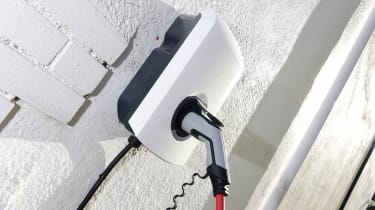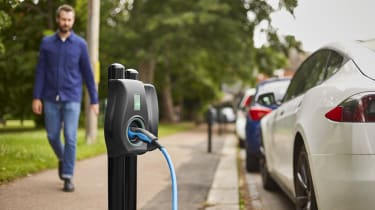What is a wallbox charger? Electric car home chargers explained
What is a wallbox charger? What does it do? Do you really need one if you have an electric car? Here, we answer the most common questions about charging your electric car at home
Owning an electric car can demand a significant lifestyle change for those who are used to driving a petrol or diesel car; filling up at a fuel station typically takes only a few minutes, but even the fastest charging electric cars take significantly longer to top up at a public rapid charger.
While this may seem inconvenient to some, and a reason to dismiss electric power altogether, it’s easy to forget that most of the time you’ll be charging your car at home. While plugging into a home wallbox is often much slower than using a public charger – think hours rather than minutes – it can be cheaper and more convenient, too.
With this in mind, you can plug in your EV the night before and wake up with a car that’s fully charged and ready to go. If you don’t plan on travelling long distances, you may never need to use a public charger – only plugging your car in at home once per week.
But what exactly is a wallbox, how do you know which one is right for you, and how you get one installed? Keep reading for our guide to understanding how wallbox charging works – we also have a guide on how to pick the right wallbox for you.

What is a home wallbox – and do I need one?
A home wallbox or home charger is a charging point you can get installed on your driveway or in your garage that can make charging and living with an electric car a whole lot easier. As well as the convenience of being able to recharge your car whenever you want, charging from a home wallbox is much faster than using a three-pin plug.
The typical charging speeds for a home wallbox range from 3kW to 7.4kW, while some are capable of up to 11KW or even 22kW if you're lucky enough to have three-phase power in your home, which can enable you to recharge an electric vehicle in only a few hours. As an example, the UK’s best-selling electric car, the Tesla Model Y, would take just over nine hours to charge in Rear-Wheel-Drive form, but using a faster three-phase 11kW charger this time is reduced to just over eight hours.
Admittedly, home chargers aren’t cheap – you can expect you to pay around £750-£1,000 for a 7kW wallbox and to have it installed as well. However, we would still recommend a home wallbox to those looking to get their first electric car because of their faster charging speeds and the additional smart features many of the latest units come packed with. More on those in a moment…
If you’re thinking about purchasing a wallbox, you should also look at what electricity tariff you’re on and whether you could switch to one designed specifically for electric-car owners. The average UK electricity price is currently 30p/kWh, taking into account the energy price guarantee – the aforementioned Model Y RWD with its roughly 60kWh battery will cost around £18 to top-up at this rate. However, with the right tariff you can potentially save even more money by charging your electric car during off-peak times. It’s worth checking with your electricity provider to see when rates are cheaper, for the most cost-effective top-ups.

How do I choose the right wallbox?
We have a full, in-depth guide that can help you choose the right home wallbox, compiled using the results of the annual Driver Power customer satisfaction survey – including feedback from owners who bought and use some of the most popular home chargers you might already be looking at. You can read all about those here.
But here is the abridged version: when choosing a wallbox charger, you first need to decide how much power you want; as we mentioned, some wallboxes offer 3kW, others 7kW, and some can even charge at 11kW or 22kW if your premises has three-phase power. However, not only are those faster units more expensive, a lot of electric cars can’t charge at these lofty speeds from an AC charger like a wallbox, so it’s worth checking if your model can before you splurge on a top-of-the-line charger. Most people will be happy with a 7kW home wallbox anyway, as it’ll provide you with plenty of juice if you plug in overnight.
In addition to the different charging speeds, home chargers are available in either tethered or untethered form, which means either with or without a built-in cable. Almost all electric car chargers will come with a Type 2 charging cable and port as this is the connector used by all new electric cars and plug-in hybrids sold in the UK.
If you’re unsure which connector is fitted to your car, check your vehicle's user manual or brochure. If you have an older electric car that uses a Type 1 connector, then not every home wallbox will work for you, but we do know the Hypervolt 2.0 charger – our Best Home Charger for 2023 – is available with either a Type 1 or Type 2 cable built-in.
Standard installation costs are usually included in the price, and a certified technician will do the job. One company says 90% of customers qualify for the free standard installation, with those falling outside the criteria needing to pay extra if further work is required. Not all home charger prices include installation though, so that’s another thing to keep in mind.

What is a 'smart' charger?
Smart chargers are connected to the internet, meaning that charging can be controlled remotely using a smartphone app. This means you can schedule charging sessions to suit your needs, either making use of the cheapest electricity overnight or guaranteeing you have a certain amount of range when you need it. You can also use the apps to track how much energy you’re putting into your car and how much it’s cost you, if you enter the price of your current energy tariff.
Are there any government grants to help with the cost?
For several years the Office for Zero Emission Vehicles (OZEV) has offered a grant of up to £350 towards the cost of a home wallbox. It was previously known as the Electric Vehicle Homecharge Scheme (EVHS), but was subsequently rebranded as the EV chargepoint grant. Scottish EV drivers are eligible for an additional £300 towards the cost and installation of a wallbox through Energy Savings Trust Scotland.
Unfortunately, the OZEV grant ended for single-unit homeowners as of 31 March 2022. It is still available to people living in apartments or rental accommodation, but there are other barriers to getting a charging point installed in those circumstances – such as whether it's you or your landlord who pays for it, and whether it's even possible to install a point when the property's parking space isn't located right next to it.
One thing worth bearing in mind is that many manufacturers, such as MINI, sometimes do deals in which they will offer a home wallbox alongside the purchase of a new car. Make sure to check with your dealer if any such offer is currently going as this could save you hundreds of pounds.
Can I use my home charger on another electric vehicle (e.g. if I was to change cars)?
If you end up selling your current electric car and swapping it for a new model, you'll still be able to use your home wallbox, as long as its connector suits the car. All new electric cars and plug-in hybrids use the European-standard Type 2 connector, so this shouldn’t be a problem if that’s the one your charger accepts.

I live in an apartment, what can I do?
If you live in an apartment, but are considering buying an electric car, you can ask the landlord or building owner to install a charging station. You may end up covering some or all of the cost of this, but you may be able to split the expense with other residents who own electric cars or are considering buying one.
If that’s not possible, you can search for nearby public charging points using apps like Zap-Map and Bonnet, as major cities like London and Liverpool are installing hundreds of on-street charging stations for people whom getting a home wallbox installed isn’t an option.
It also may be worth signing up for one or several EV charging subscriptions, such as bp pulse or Tesla Supercharger membership, as these can drastically reduce your charging costs if you use public infrastructure frequently. However, using a home wallbox will almost always be cheaper.
